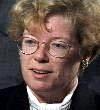A Hot Big Bang with Density RipplesThe second key embellishment to the basic bare-bones model is to add small density ripples just after the original hot Big Bang. By “density ripples,” I mean that the combined density of matter and energy varied slightly from place to place in the early Universe. We can think of ripples as small-scale peaks and valleys of density piled on larger-scale peaks and valleys, much as tiny ocean waves riffle the surface of long rollers. Since, according to Einstein, it is the combined matter-energy density that generates the gravitational field, even tiny ripples generate perturbations in the gravitational field. Consider, for example, the neighborhood around a matter-energy peak. Particles near the peak feel a net gravitational force pulling them toward its center and retarding their outward expansion. Ultimately they fall back into it, which increases its mass still more. The net result is a gravitational runaway in which growing peaks come to dominate and gobble up ever larger regions. By the same token, underdense regions, called “voids,” expand faster than average, emptying out over time as their matter is stolen away by nearby peaks. The physics of peak formation is quite well developed. Each region around a peak can be regarded as a “bound” mini-universe that expands for awhile, reaches a maximum radius, and then collapses back on itself to form a self-gravitating object. Such collapsed objects remain embedded in the Hubble flow and expand with the rest of the Universe. The first collapsed objects formed roughly a billion years after the Big Bang and had a mass of about a million solar masses, the size of a globular star cluster. They in turn were clumped irregularly (due to larger-scale density ripples), and clusters of them quickly began to merge. These clumps merged into yet larger clumps in a grand clustering hierarchy. Collapse and clustering is the process that built all the structure in the Universe we see today. The first objects to form were star clusters and small galaxies. These soon merged to form larger galaxies, and finally groups and clusters of galaxies. The process is continuing today, building mammoth superclusters containing thousands of galaxies that are separated by empty voids up to 300 million light years across. Key to this process is the origin and nature of the original density ripples, as their sizes, locations, and peak heights determine all subsequent gravitational clustering. I will say more about the origin of these ripples shortly, but for now I simply note that there exists a conceptually simplest theory for their strength versus mass, the so-called Harrison-Zeldovich spectrum. Their clustering behavior also depends on the nature of the matter in the Universe, whether it is mostly normal “baryonic” matter or some unknown form of “dark matter” particles, and, if dark, whether massive, “cold” particles or light, “hot” particles. Assuming that all of this is known, the whole collapse process can be predicted in great detail: when objects of a given mass will form, how large their radii will be, and how fast the particles inside them will orbit. The best-fitting theory says that the original ripples had a Harrison-Zeldovich spectrum and then grew in a Universe whose matter consists mostly of cold dark matter. Rather amazingly, this picture matches the masses, radii, and orbital speeds within galaxies and clusters over nine orders of magnitude in mass, from small galaxies up to huge superclusters.
Contributed by: Dr. Sandra Faber |
|
A Hot Big Bang with Density Ripples
Source: Sandra Faber Related Media:
Other Resources:
|




